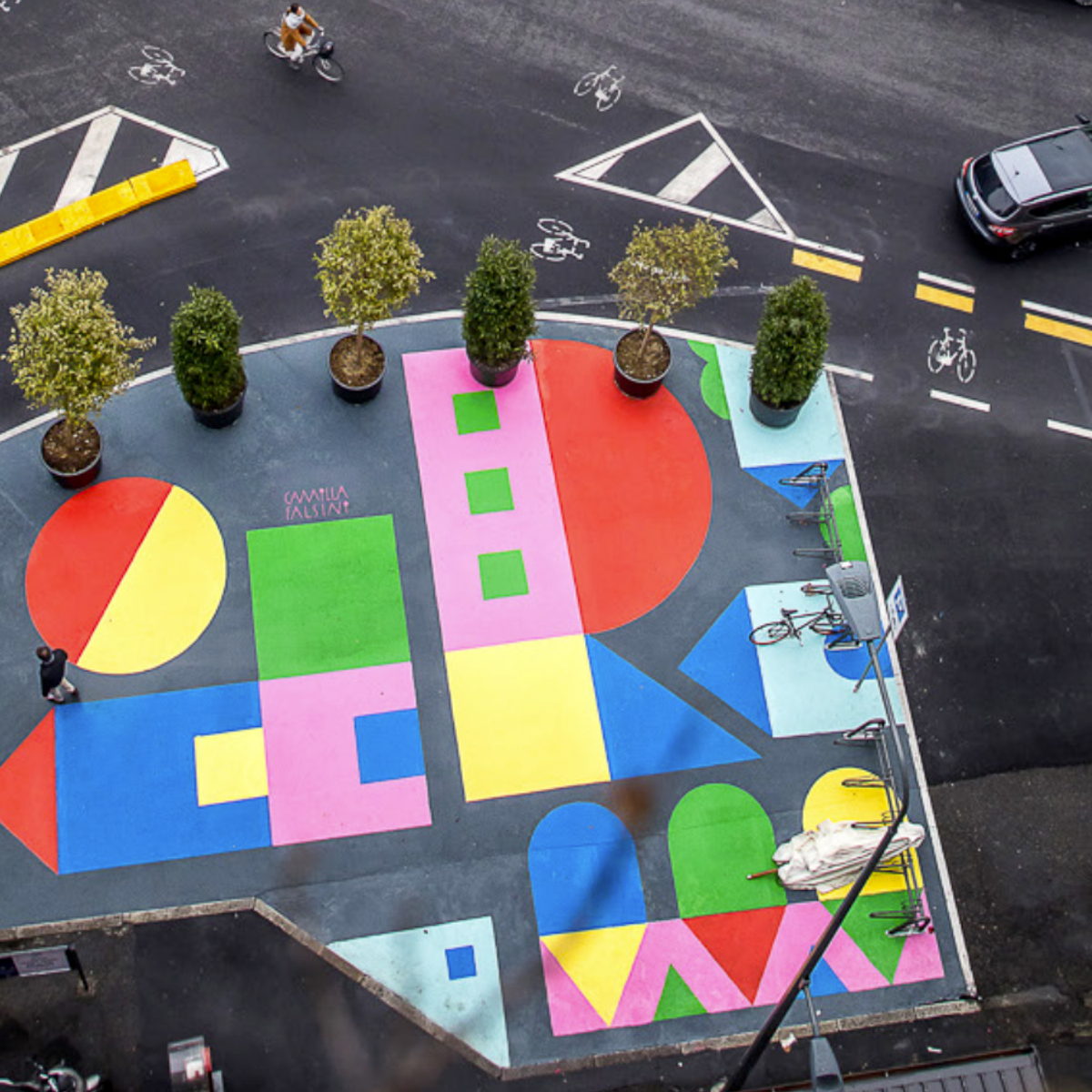
Our streetscape, despite its feeling of permanence in our environment, is an ideal venue for experimentation. We have come to accept traffic movement as the default function for the street. Therefore, we need to rethink its design and space distribution, go back to its original and basic function and see them as public spaces - Transform them into places for social activities, where conversations can take place and places where kids can play. This course shows you examples of remarkable changes and gives you a toolbox for implementing and evaluating street experiments yourself. We invite you on this journey to reimagine what is possible if we dare to use our public space differently.
What's inside
Syllabus
Streets as Placemaking and Movement (Raising Awareness)
This week, we will explore how the COVID-19 pandemic served as a catalyst to open people's thinking about using streets for more social purposes and answer the question, "can functions of mobility and public space co-exist and simultaneously increase the liveability of cities?" We will visit a brief history of the evolution of streets, both in concept and using historical examples, and see how ideology influences people's willingness to reshape the street for different functions. Surprisingly, even automakers see the limitations of cars and are taking steps to hedge against different mobility futures by investing in street experiments and shared mobility.
Read more
Syllabus
Good to know
Save this course
Activities
Revise road design fundamentals
Show steps
Review basic principles of road design to ensure a strong foundation for understanding concepts in the course.
Show steps
-
Review textbooks and class notes from previous courses on road design.
-
Solve practice problems related to road geometry, capacity analysis, and intersection design.
Read 'Street Fight: Handbook for an Urban Revolution'
Show steps
Gain insights from a practical guide that showcases successful street transformation projects and provides strategies for creating more livable and sustainable streets.
Show steps
-
Read the book thoroughly, taking notes on key concepts and examples.
-
Identify parallels between the book's content and the topics covered in the course.
Explore case studies of successful street experiments
Show steps
Analyze real-world examples of effective street experiments to gain practical insights and identify best practices.
Browse courses on
Street Experiments
Show steps
-
Visit websites and online platforms showcasing street experiment case studies.
-
Review articles and reports documenting the implementation and outcomes of these experiments.
-
Identify common elements and strategies that contributed to their success.
Five other activities
Expand to see all activities and additional details
Show all eight activities
Engage in peer discussions on street experiments
Show steps
Share ideas, experiences, and challenges related to street experiments with fellow students to gain diverse perspectives and foster collaboration.
Browse courses on
Street Experiments
Show steps
-
Form or join a study group or online forum focused on street experiments.
-
Initiate and participate in discussions on topics such as experiment design, implementation, and evaluation.
-
Provide constructive feedback and learn from the insights of others.
Explore online resources on street accessibility
Show steps
Enhance understanding of accessibility considerations in street design to ensure inclusive and equitable public spaces.
Browse courses on
Universal Design
Show steps
-
Visit websites and platforms dedicated to street accessibility best practices.
-
Review guidelines and case studies on accessible street design elements, such as curb ramps, pedestrian crossings, and tactile paving.
-
Identify design principles that promote universal access and inclusivity.
Attend a workshop on street traffic analysis
Show steps
Gain hands-on experience in conducting traffic analysis and understanding its role in street experiment design.
Browse courses on
Traffic Analysis
Show steps
-
Research and identify relevant workshops or conferences on street traffic analysis.
-
Register and attend the workshop, actively participating in discussions and exercises.
-
Network with professionals in the field and learn about latest trends and best practices in traffic analysis.
Design a street experiment proposal
Show steps
Develop a comprehensive proposal outlining a hypothetical street experiment, including its goals, methodology, and evaluation plan.
Browse courses on
Traffic Management
Show steps
-
Identify a specific street or intersection for the experiment.
-
Define the desired outcomes and objectives of the experiment.
-
Develop a detailed plan for implementing the experiment, including traffic diversion, signage, and safety measures.
-
Outline a strategy for evaluating the experiment's effectiveness, using both quantitative and qualitative data.
Contribute to open-source projects related to street mobility
Show steps
Gain practical experience in applying concepts learned in the course by contributing to real-world projects that advance street mobility.
Browse courses on
Open-Source Software
Show steps
-
Identify open-source projects related to street mobility, such as traffic simulation software or data analysis tools.
-
Review the project's documentation and contribute code, documentation, or bug fixes.
-
Collaborate with other contributors and learn from their expertise.
Revise road design fundamentals
Show steps
Review basic principles of road design to ensure a strong foundation for understanding concepts in the course.
Show steps
- Review textbooks and class notes from previous courses on road design.
- Solve practice problems related to road geometry, capacity analysis, and intersection design.
Read 'Street Fight: Handbook for an Urban Revolution'
Show steps
Gain insights from a practical guide that showcases successful street transformation projects and provides strategies for creating more livable and sustainable streets.
Show steps
- Read the book thoroughly, taking notes on key concepts and examples.
- Identify parallels between the book's content and the topics covered in the course.
Explore case studies of successful street experiments
Show steps
Analyze real-world examples of effective street experiments to gain practical insights and identify best practices.
Browse courses on
Street Experiments
Show steps
- Visit websites and online platforms showcasing street experiment case studies.
- Review articles and reports documenting the implementation and outcomes of these experiments.
- Identify common elements and strategies that contributed to their success.
Engage in peer discussions on street experiments
Show steps
Share ideas, experiences, and challenges related to street experiments with fellow students to gain diverse perspectives and foster collaboration.
Browse courses on
Street Experiments
Show steps
- Form or join a study group or online forum focused on street experiments.
- Initiate and participate in discussions on topics such as experiment design, implementation, and evaluation.
- Provide constructive feedback and learn from the insights of others.
Explore online resources on street accessibility
Show steps
Enhance understanding of accessibility considerations in street design to ensure inclusive and equitable public spaces.
Browse courses on
Universal Design
Show steps
- Visit websites and platforms dedicated to street accessibility best practices.
- Review guidelines and case studies on accessible street design elements, such as curb ramps, pedestrian crossings, and tactile paving.
- Identify design principles that promote universal access and inclusivity.
Attend a workshop on street traffic analysis
Show steps
Gain hands-on experience in conducting traffic analysis and understanding its role in street experiment design.
Browse courses on
Traffic Analysis
Show steps
- Research and identify relevant workshops or conferences on street traffic analysis.
- Register and attend the workshop, actively participating in discussions and exercises.
- Network with professionals in the field and learn about latest trends and best practices in traffic analysis.
Design a street experiment proposal
Show steps
Develop a comprehensive proposal outlining a hypothetical street experiment, including its goals, methodology, and evaluation plan.
Browse courses on
Traffic Management
Show steps
- Identify a specific street or intersection for the experiment.
- Define the desired outcomes and objectives of the experiment.
- Develop a detailed plan for implementing the experiment, including traffic diversion, signage, and safety measures.
- Outline a strategy for evaluating the experiment's effectiveness, using both quantitative and qualitative data.
Contribute to open-source projects related to street mobility
Show steps
Gain practical experience in applying concepts learned in the course by contributing to real-world projects that advance street mobility.
Browse courses on
Open-Source Software
Show steps
- Identify open-source projects related to street mobility, such as traffic simulation software or data analysis tools.
- Review the project's documentation and contribute code, documentation, or bug fixes.
- Collaborate with other contributors and learn from their expertise.
Career center
Environmental Planner
Resilience Manager
Sustainability Manager
Transportation Planner
Economic Development Director
Community Development Director
Social Planner
Urban Planner
City Manager
Mayor
Landscape Architect
Civil Engineer
Architect
Transportation Engineer
Environmental Engineer
Reading list
Share
Similar courses
OpenCourser helps millions of learners each year. People visit us to learn workspace skills, ace their exams, and nurture their curiosity.
Our extensive catalog contains over 50,000 courses and twice as many books. Browse by search, by topic, or even by career interests. We'll match you to the right resources quickly.
Find this site helpful? Tell a friend about us.
We're supported by our community of learners. When you purchase or subscribe to courses and programs or purchase books, we may earn a commission from our partners.
Your purchases help us maintain our catalog and keep our servers humming without ads.
Thank you for supporting OpenCourser.



